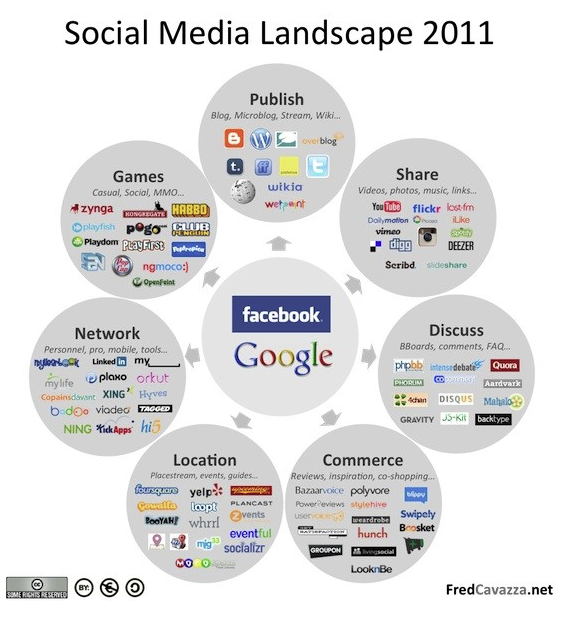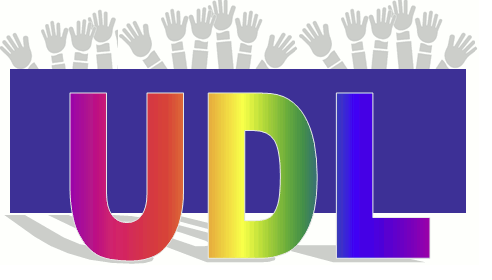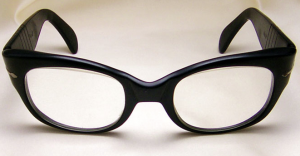My friend Chris Landry is a fabulous videographer and he really does tell great stories. Recently he created this gem:
Month: September 2011
Paper Wigs
Even with all the technology I handle on a daily basis….I still really enjoy working with paper. Nikki Salk and Amy Flurry have created a dramatic exploration at the intersection of paper craft and high fashion.
The Alphabet 2-Stop Motion Video
The Alphabet 2
The Alphabet 2 from n9ve on Vimeo.
Social Media Landscape
Fred Cavazza has done an extraordinary job pulling the Social Media Landscape into this Blooms Taxonomy.
It is interesting to see how Facebook and Google form the hub, I’d include Twitter in there as well. I also am liking Tumblr again.
View a high resolution of this image by clicking here.
MassCUE: Connecting the Dots
I spent the day in Marlborough, Massachusetts Connecting the Dots with others investigating some of the hot issues in education. We rotated through 35 minute discussions and shared challenges, information, ideas and best practices with our peers from around the region.
This event also featured a special keynote, Ron Crouch, who with his amazing ability with numbers helped us better understand the demographics of our region and how that information will shape the needs of the area education organizations in the months and years to come. Ron’s presentation was fascinating and I am still absorbing the pages of information and data he shared.
More than just a briefing, this fast paced planning session brought together K-12 district and Department of Education staff to discuss, reflect, and prepare for what is to come. I participated in roundtable group discussions on topics such as:
• Classroom Technologies
• Funding Challenges and Opportunities
• Professional Development
• Social Media
• Online Learning and Digital Content
It was a day well worth the foggy drive out east.
I am looking forward to presenting at the Massachusetts Computer Using Educators’ [MassCUE’s] 2011 Annual Technology Conference, This 2-day event-October 26 & 27th, 2011- is co-sponsored by the Massachusetts Computer Using Educators and the Massachusetts Association of School Superintendents [M.A.S.S.].
Universal Design for Learning
To meet Universal Design principles, educational processes should:
1. Be accessible and fair.
2. Provide flexibility in use, participation, and presentation.
3. Be straightforward and consistent.
4. Be explicitly presented and readily perceived.
5. Provide a supportive learning environment.
6. Minimize unnecessary physical effort or requirements.
7. Ensure a learning space that accommodates both students and instructional methods.
The beneficiaries of Universal Design in education include:
• Students with special needs, including those with disabilities.
• Students with English as a second language.
• The general population of students, all of whom will benefit from the application of Universal Design principles.
A great slide show by Eleonora Guglielman
What Do You Read?
I was recently asked what professional publications and social media I enjoy engaging with. I hadn’t realized how long the list has become. These are some of my favorites and regulars [in no particular order]:
Social Media:
- WordPress [and WordPress Community]
- YouTube
- Vimeo
- SlideShare
- Tumblr- from time to time
Reading and Research:
- The New York Times
- NPR
- TechCrunch
- Slate
- Whitehouse.gov
- TED
- Wired
- Higher Ed
- iNOCOL: the International Association for K-12 Online Learning
- iste: the International Society for Technology in Learning
- Education Week
- The Rapid eLearning Blog
- Fast Company Blog
- Open Culture Blog
- Daniel PInk’s Blog
- Seth Godin’s Blog
- Various Instructional Design Blogs
- Anything by Cliff Kuang -infographic guru
I am still adding…..so visit again…..after you have checked out some of these good reads….
Turning Social Media On Its Side
The surprise star at Facebook’s f8 conference was Nicholas Felton, whom Facebook’s head product developer credited with inspiring the layout of the revamped Facebook. How’d that happen?
“His work was a huge inspiration on a lot of the big ideas that we presented today,” Facebook VP of product Christopher Cox said yesterday. It was the f8 developers’ conference, and Cox was talking about Timeline, the hotly anticipated third-generation redesign of Facebook’s profile page. Timeline exchanges Facebook’s standard single-column, scroll-down format for a more horizontally oriented tile-based interface that’s designed like a “scrapbook-on-steroids,” as my colleague E.B. Boyd put it.
If Timeline is successful, it could alter how people absorb data not just on Facebook, but also on the rest of the Internet (making a lot of money in the process). How? Simply by turning everyone into Nicholas Felton.
Timeline aims to turn Facebook into even more of a central hub for your life.
Right now, your Facebook page discriminates against the past. That’s a design problem: Click on someone’s profile, and all you see are their latest updates, their latest likes, and their latest photos. You have to scroll and scroll and scroll to get any sort of sense about who someone is over any time period larger than a day. Facebook, according to Cox, was struggling to solve this problem before Felton came aboard: A prototype that he nodded to in his presentation, at a glance, seemed cluttered and busy.
Timeline, by contrast, includes an actual timeline, organized in tiles across two columns like a virtual noteboard, that lets you present your autobiography from birth to now. You do it in your own words and with your own pictures, which means you’re free to highlight the milestones (the wedding, say) and bury the embarrassing moments (the bachelorette party). Then you top it off with a mega-huge panoramic photo of yourself or, for the camera-shy among us, a “unique image that represents you best,” to quote the site.
The tiles within your timeline can also include apps: One for tracking your music (and letting others listen to it as well through Spotify), and another to track the movies you watched (with Netflix), and another to track the number of miles you ran, and even the precise route you ran (with Nike+). In short, it centralizes and publicizes all of the details in your life that you never fully log.
Gimme Bar: An App That Lets You Clip and Save From the Web
This is basically a virtual version of a pin-up board for inspirations. It could be an interesting way for students to “pull” information and ideas into an ePortfolio.
New Gimme Bar Demo from Gimme Bar on Vimeo.
Chipotle’s Amazing Stop Motion Film
Chipotle eschews the icky practices of factory farming. Michael Pollan would surely approve.





